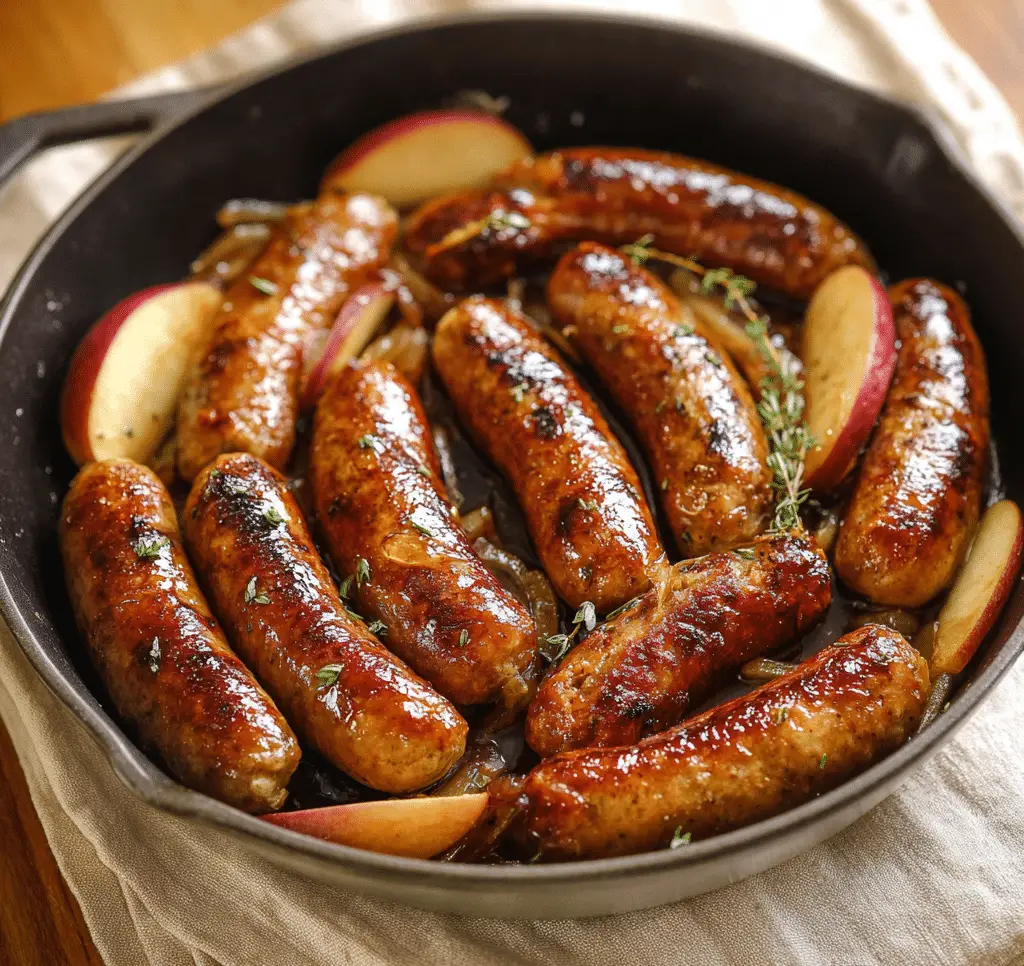Melt-in-your-mouth sausages get dressed in a luscious maple-mustard glaze, accompanied by caramelized apples and onions. This easy skillet meal transforms humble ingredients into a cozy dish perfect for crisp evenings or relaxed weekends.
This Sweet & Savory Maple Sausage Medley brings together the earthy flavors of pork, the sweetness of pure maple syrup, and the gentle spice of Dijon and smoked paprika. It’s a delightful celebration of autumn tastes that’s simple enough for a weeknight but satisfying enough for a family feast.
Full Recipe
Ingredients:
-
-
1 lb (450 g) Italian sausages (mild or sweet)
-
2 tablespoons unsalted butter
-
1 small yellow onion, sliced
-
2 apples (e.g., Honeycrisp), cored and cut into wedges
-
2 tablespoons pure maple syrup
-
1 tablespoon Dijon mustard
-
½ teaspoon smoked paprika
-
Salt and fresh ground black pepper, to taste
-
Fresh thyme or parsley, chopped (for garnish)
-
Directions:
-
-
In a large skillet over medium heat, melt the butter. Add sausage links and cook, turning occasionally, until browned on all sides, about 7–8 minutes.
-
Add the sliced onion and apple wedges to the skillet. Sauté 4–5 minutes until onions soften and apples begin to caramelize.
-
In a small bowl, whisk together maple syrup, Dijon mustard, smoked paprika, salt and pepper.
-
Pour the maple‑mustard mixture over the sausages, onions, and apples; stir gently to coat everything. Continue cooking 3–4 minutes until the glaze thickens and coats the ingredients.
-
Taste and adjust seasoning if needed. Sprinkle with fresh thyme or parsley before serving.
-
Prep Time: 10 minutes | Cooking Time: 15 minutes | Total Time: 25 minutes | Kcal: approx. 380 kcal per serving | Servings: 4
The Inspiration Behind the Maple Sausage Skillet
This dish draws its charm from the intersection of rustic simplicity and bold seasonal flavors. Inspired by classic European skillet meals and infused with New England-style maple sweetness, the Maple Sausage Skillet celebrates the cozy, hearty meals we crave during the colder months. Apples and onions have long been paired with pork, but the addition of maple syrup and Dijon mustard elevates the experience to something uniquely comforting and balanced. This recipe pays homage to traditional fall harvest meals, where ingredients are straightforward, locally sourced, and allowed to shine.
Why This Recipe Works
What makes this recipe truly successful is the way contrasting flavors are layered and balanced. The sausage provides a savory and hearty base, rich with seasoning and depth. The apples offer a fresh, sweet contrast and soften during the sautéing process, adding not only taste but texture. Onions bring a touch of sharpness and mellow sweetness, especially when caramelized in butter. Finally, the maple-Dijon glaze brings everything together with sweet, tangy, and slightly smoky notes, courtesy of the smoked paprika.
The preparation is incredibly efficient—everything is made in a single skillet. This means less cleanup and more time enjoying the meal with friends or family. It’s also very flexible in terms of the ingredients: you can swap sausages, switch apples for pears, or change the glaze profile by adjusting mustard types.
The Role of Maple Syrup
Pure maple syrup is the true star here, not just a sweetener but a flavor enhancer. It brings out the best in the apples and helps caramelize the sausage and onion beautifully. Unlike refined sugar or artificial syrups, real maple syrup has subtle undertones of vanilla, toffee, and even floral notes, making it a perfect complement to savory ingredients.
Using Grade A dark maple syrup provides the deepest flavor, ideal for cooking. It’s not overly sweet and contributes a complex richness that rounds out the dish.
Choosing the Right Sausage
This recipe works best with sweet or mild Italian pork sausages, but it’s also excellent with chicken or turkey sausage if you’re looking for a lighter alternative. Avoid overly spiced or hot varieties, as they can overpower the gentle sweetness of the apples and syrup. Sausages with hints of fennel or sage pair particularly well, echoing the herbal, woodsy tones of the dish.
For the health-conscious, you can use nitrate-free, organic sausage or even experiment with plant-based sausage alternatives for a vegetarian version. Just ensure whatever you use can stand up to searing and hold its shape when glazed.
The Importance of Apple Variety
Apples are not just a garnish here—they’re a key ingredient. That’s why choosing the right variety matters. You want apples that hold their shape when cooked but still offer a juicy bite and sweet flavor. Honeycrisp is a favorite because of its balanced sweet-tart profile and firm texture. Fuji and Gala are also excellent choices. If you prefer more tartness, Granny Smith apples add a punchy contrast to the maple glaze.
Apples also change texture and sweetness slightly as they cook, so testing the timing of your sautéing is essential for achieving that ideal balance between softness and structure.
How to Make the Glaze Pop
The maple-Dijon glaze is what transforms this dish from ordinary to outstanding. Combining mustard with maple syrup brings acidity and tang that prevents the dish from being too sweet. Smoked paprika adds a subtle warmth and depth. If you like a bit more punch, a small splash of apple cider vinegar or a dash of cayenne can elevate it further.
The trick to getting the glaze just right is letting it simmer until it slightly thickens and coats the ingredients with a glossy finish. Stirring gently during the last few minutes ensures that each bite gets a bit of every flavor note.
A Perfect One-Skillet Meal for Any Occasion
Beyond flavor, this recipe is incredibly practical. It’s a one-skillet wonder, making it a go-to for busy weeknights, yet elegant enough for a weekend brunch or dinner party. Serve it with crusty bread, mashed potatoes, or even roasted root vegetables for a heartier meal. It also pairs beautifully with a crisp green salad dressed in a cider vinaigrette.
For breakfast or brunch, serve it alongside scrambled eggs or baked eggs right in the skillet. For dinner, a glass of dry hard cider, a Pinot Noir, or an amber ale will enhance the meal beautifully.
Tips for Storage and Reheating
This dish stores very well, making it ideal for meal prep. Simply cool leftovers completely before placing in an airtight container. Refrigerate for up to 4 days. When reheating, do so gently in a skillet over medium-low heat to preserve the glaze’s texture. You can add a splash of water or broth to rehydrate the glaze if needed.
Freezing is possible but may alter the texture of the apples. If freezing, let the dish cool completely, portion into freezer-safe containers, and freeze for up to 2 months. Thaw overnight in the fridge before reheating.
Make It Your Own
Customization is easy with this dish:
-
Vegetables: Add bell peppers, brussels sprouts, or even baby potatoes to the skillet.
-
Herbs: Finish with rosemary instead of thyme for a bolder pine-like aroma.
-
Spice: Add chili flakes or cayenne to the glaze if you enjoy a kick.
-
Protein swap: Try chicken thighs or even tofu for different flavor experiences.
It’s also a great dish for introducing kids to savory-sweet flavor combinations because it’s both approachable and fun to eat.
Nutritional Benefits
This dish delivers a satisfying balance of protein, fiber, and natural sugars. You get clean energy from the apples, while the sausages offer filling protein and fats. The natural sugars from the maple syrup are easier to metabolize than refined sugars, and the use of butter in moderation adds to the satiety without going overboard.
Adding greens on the side boosts the nutrient profile further, making this not just a comfort food—but a meal you can feel good about serving your family.
Conclusion
The Maple Sausage Skillet is more than just a quick and easy recipe—it’s a warm embrace in the form of food. It combines rustic flavors with a touch of sophistication through its thoughtful glaze, vibrant produce, and balanced textures. Whether you’re serving it on a weeknight or showcasing it during a fall brunch, it brings comfort, richness, and heart to the table.
This is a recipe that speaks to tradition and creativity all at once. It invites experimentation while delivering consistently delicious results. Keep it in your seasonal rotation, and it will soon become one of those “back-pocket” meals that you can rely on to please any crowd—without any fuss.






